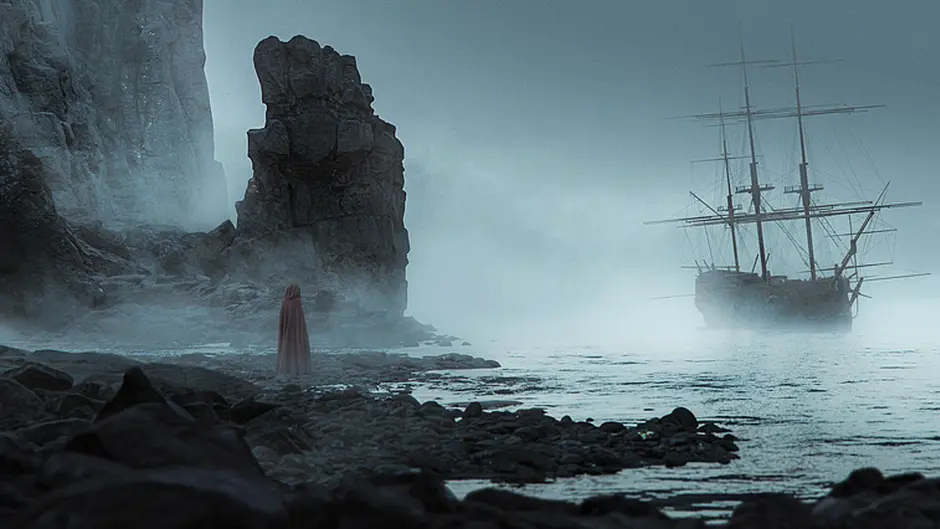The West Cork coastline is known for its beauty, but beneath the stunning scenery you will find spooky happenings along the craggy coast and strange creatures lurking beneath the waves, says Pauline Murphy
ACCORDING to the Paranormal Database, in the 1800s a small sailing ship known as Ceylon encountered a bad storm and hit rocks near Galley Head lighthouse and all onboard were lost.
For weeks after the incident, locals witnessed a ship which looked similar to Ceylon sailing towards Galley Head. The three-masted ship would sail towards the coastline over and over again before suddenly disappearing into the rocks. Those who saw the ship claimed that it was an apparition of Ceylon replaying its doom in order to warn others away from the deadly spot.
Years later, in the springtime of 1906, a fishing boat off the Old Head of Kinsale was attacked by a large fearsome fish. The fishermen had never seen such a frightening pod of creatures which continuously rammed the boat for almost half an hour.
The terrifying ordeal only ended when the captain made the decision to turn off the engines and the creatures disappeared back into the depths of the sea.
Fast forward over 30 years, and in the 1930s School Folklore Collection there lies a hair-raising tale of another phantom ship.
A pupil of Bantry National School wrote about local fisherman Dick Murphy who went out fishing one night with his friend Jack MacCarthy. While out on Bantry Bay, they saw a white boat coming at speed towards them.
The strange boat suddenly came to a stop next to the fishermen and a tall eerie-looking man appeared. MacCarthy got such a fright that he fell back, broke his neck and died. The strange man then bellowed at Murphy ‘Go home, the night is for the dead!’
Then the stranger vanished, along with the white boat, under the waves. The terrified fisherman rowed as fast as he could back to shore and never ventured out to sea again.
But some years earlier, on July 30th 1915, an engagement between a German U-boat and a British steam ship off Fastnet Rock resulted in the appearance of a sea monster.
Commander of U-28, Freiherr George G von Forstner ordered a torpedo to be launched against the steamer ship Iberian 17km south west of Fastnet Rock.
When the torpedo hit the ship, a great explosion occurred, which threw a large creature up from the depths of the sea and into the air.
The U-boat commander wrote about what he had witnessed in his log.
‘There was a violent explosion, which shot pieces of debris, among them a gigantic aquatic animal, out of the water to a height of approximately 80ft,’ he wrote. ‘At that moment I had with me six of my officers of the watch, including the chief engineer, the navigator and the helmsman.
‘Simultaneously we all drew one another’s attention to this wonder of the seas, which was writhing and struggling among the debris.
‘We were unable to identify the creature, but all of us agreed that it resembled an aquatic crocodile which was about 60ft long with four limbs resembling large webbed feet, a long pointed tail and a head which also tapered to a point.
‘Unfortunately, we were not able to take a photograph, for the animal sank out of sight after ten or fifteen seconds.’
Another sea serpent was spotted off the West Cork coast in the early 20th century. Arthur Rostron was chief officer of RMS Campania when, on April 26th 1907, he and his crew had a scary encounter off Galley Head.
He wrote about it in his memoir Home from the Sea. ‘Off Galley Head I noticed something sticking out of the water. ‘Keep clear of the snag right ahead’ I called out to the junior officer who was with me on the bridge.
‘We swung away to a point but gradually drew nearer, so that we were able to make out what the unusual thing was. It was a sea monster! It was no more than 50ft from the ship’s side when we passed it, and so both I and the junior officer had a good sight of it. We were close enough to realise its head rose eight or nine feet out of the water, while the trunk of the neck was fully 12 inches thick.’
The creature they witnessed quickly disappeared back under the water and they never saw it again. Just a few years later Arthur Rostron was knighted for his role as the captain of RMS Carpathia, the ship which rescued survivors of the Titanic in 1912.
Apart from ghost ships and sea serpents, the coastline of West Cork also harbours spine-tingling tales of cursed treasure. Again, the School’s Folklore Collection is its own treasure when it comes to unusual stories.
A tale was told within its pages by a pupil in Kinsale about pirate gold. Many centuries ago, pirates came ashore at the southern part of the Old Head of Kinsale to bury gold they had looted from elsewhere.
The pirate captain asked one of his men to stay and mind the treasure. When one of them agreed to do so, the captain shot him dead and buried his body with the gold! Anyone who dares to hunt for the buried treasure is now confronted by the ghost of the pirate who was buried with it and, apparently to this day, he continues to haunt the area.
Near Mizen Head you will find another blood-curdling pirate tale. According to local lore, Canty’s Cove is named for a cutthroat pirate who settled there.
Overlooking the remote cove is an area known as Canty’s Garden, where the pirate Canty built a lodging house and carried out his dastardly deeds.
Weary travellers who stopped for a rest at Canty’s house were robbed by the ruthless pirate before he then flung them to their death down into the cove. Over the years many people have claimed they heard screams late at night coming from Canty’s Cove and strange lights floating about Canty’s Garden.
Like the remote and rugged Canty’s Cove – every rock and lapping wave along the West Cork coastline has a strange and scary tale to tell!










